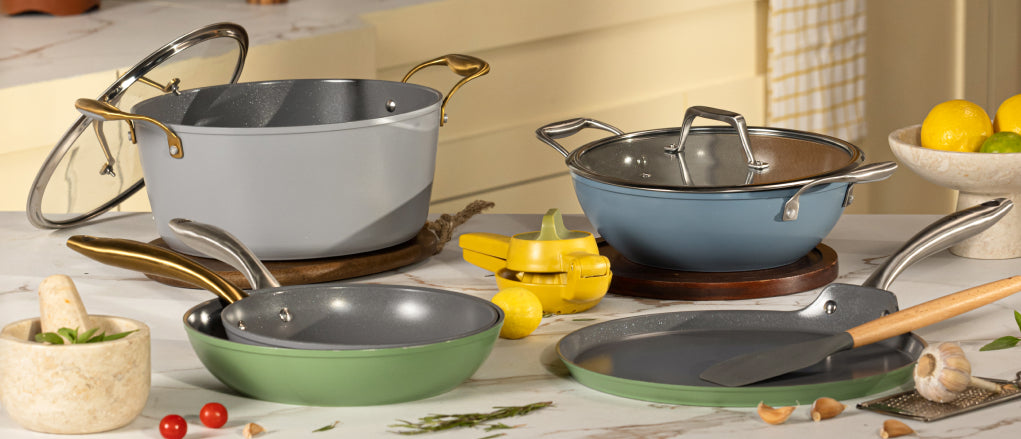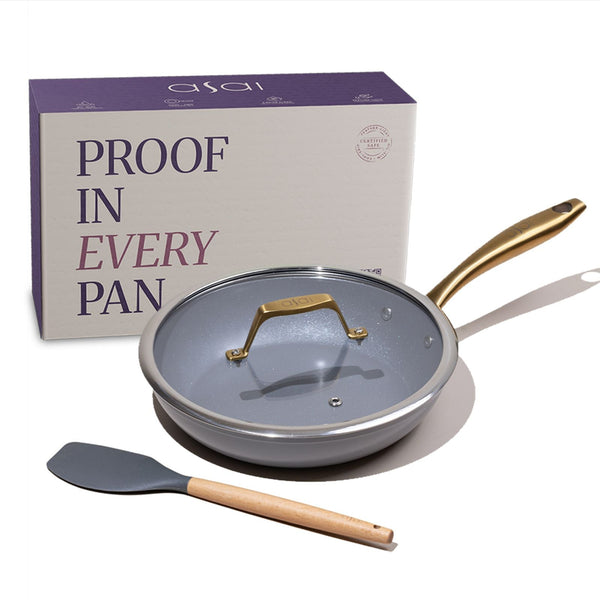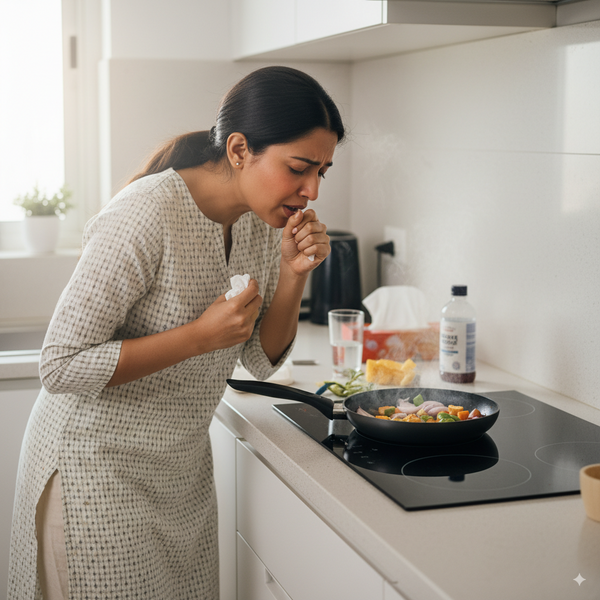Ceramic vs Cast Iron: What’s Really Best for Indian Home Cooking?
Why Your Cookware Material Makes a Big Difference in Indian Cooking
When you’re making dal, crispy dosas, or that one-pot khichdi that fuels your week, what you cook in turns out to matter more than you’d think. It changes the flavor. The texture. Heck, even the nutrients you end up eating. The reality is, it isn’t just the masalas or the oil—it’s what’s underneath it all. So next time you’re eyeing that shiny new pan, remember: your cookware choice can shape every meal, festival spread, or rushed Tuesday night dinner.
What Sets Cast Iron and Ceramic Apart? (A Quick Guide to Their Makeup and Best Uses)
Alright, no chemistry lecture—just the basics.
Cast iron pans are mostly, well, iron—sturdy, heavy, and known for sticking around the kitchen for long. They’re legendary for things like roti tawas, kadais, and getting that perfect dosa crisp.
Ceramic, on the other hand, is usually a metal pan (think aluminium or steel) with a natural, sand-derived ceramic coating on top. It’s lightweight, non-stick (bless!), and a go-to for stir-fries, upma, omelettes—you name it.
So, cast iron is your workhorse for grandma’s recipes, and ceramic? That’s your daily driver when you want things done fast.
How Do Cast Iron and Ceramic Really Perform in the Kitchen?
Heat Retention, Conductivity, and Durability: What to Expect
Here’s why this isn’t just a side note: cast iron holds on to heat like it’s got separation anxiety, which is fantastic for slow-cooking or keeping pakoras crispy long after the oil’s off[1]. Ceramic heats up fast, spreads warmth evenly, but cools off just as quickly—great for stir-frying bhindi or tossing together an egg fry[2].
And let’s talk durability. Cast iron, if you give it some love, might just outlast you. Ceramic does well for a good 3-5 years if you’re not clanking it around. Just don’t drop it—it will chip.
Reactivity with Food: Is One Safer or Tastier Than the Other?
Cast iron can add a pinch of iron to your food—actually a bonus in India, where iron deficiency is a real thing for half of all women[1]. But, leave tomato or lemon gravies simmering for an hour, and you might taste a little iron too (not always what you want). Ceramic? Nope. Doesn’t react, doesn’t leach. It’s the go-to if you love tangy tomato curry.
Pros, Cons, and Everyday Trade-Offs: Which Material Fits Your Cooking Style?
Let’s keep it real. Here’s the quick breakdown:
| Feature | Cast Iron | Ceramic |
|---|---|---|
| Durability | 5-10 years of service | 3-5 years if you’re careful |
| Weight | Heavy (arm workout included) | Lightweight, easy to handle |
| Non-stick? | Needs seasoning, gets better | Non-stick from day one |
| Cleaning | Needs maintenance, avoid soaking | Simple, just don’t scratch it |
| Heat | High/slow cooks, deep frying | Quick meals, shallow fry-ups |
| Acidic Foods | Use briefly only | Totally fine |
If you love a kitchen marathon—slow curry, endless roti—cast iron’s your friend. For weekday speed and less oil? Ceramic might just win. Here is showcasing Asai's Ceramic Collection.
How to Care for Cast Iron vs Ceramic (and Make Them Last Longer)
Honestly, cast iron asks for more TLC. Skip the soaking, use just a bit of soap, dry asap, and rub in some oil now and then. That’s how it keeps its non-stick soul[1][2]. Ceramic pans like gentle hand-washing, no aggressive scrubbing, and definitely no metal spatulas. We have created a full series for you to care for your ceramic pans - you must check it out!
When Should You Choose Cast Iron, and When Does Ceramic Work Better?
If you’re aiming for dosa that cracks like firewood or poori that stays puffy, cast iron is unbeatable. Want to toss veggies at high speed, whip up scrambled eggs, or handle delicate tomato gravies? Ceramic feels like cheating (in a good way). And with fewer worries about rust or pan weight, it’s a blessing for busy families. Particularly, ceramic pans would be loved by the hoom cooks as it is almost 1/4th the weight of traditional cast iron pans.

Safety Check: What About Health, Food Reactivity, and Quality?
Here’s the thing: cast iron gives your food a hit of extra iron—handy if you’re low, but not so much with super acidic stuff[1]. With ceramic, as long as you buy the lead-free, cadmium-free variety (Asai pans are absolutely heavy-metal free - you can check out in our Asai Lab section further), you don’t have to stress over what might be getting into your food[2]. Just remember, any old non-stick pan can wear out—ceramic included—so don’t hang onto it forever.
How Do Cast Iron and Ceramic Compare with Other Popular Cookware?
Let’s be real: stainless steel is solid for flavour and durability but it sticks and scorches thick sauces if you look away for a moment[3]. Old-school PTFE non-stick? Fine for low-heat, but don’t crank the burner—it doesn’t handle heat like iron or ceramic, and the fumes are no joke. For heat safety and oil reduction, cast iron and ceramic both leave classic non-stick in the dust[1].
What the Experts Say (Plus Surprising Science on Iron and Oil Use)
Research says food in cast iron pans can have up to 16% more iron[1]—huge if you’re dealing with low iron levels. Also, a cast iron tawa weighs double what a ceramic one does, so if you’re cooking for the extended family, maybe switch it up sometimes[2]. Even chef Sanjeev Kapoor is on team “both”—use cast iron for big flavors, but ceramic makes daily life so much easier. One more thing: ceramic pans can cut your oil use by a quarter, which fits right in with that whole eat-better promise most of us are trying to keep[1][2].
Real Questions People Ask About Cast Iron and Ceramic in Indian Kitchens
Is cast iron safe for tomato curries?
Yes, as long as you’re not simmering forever. Short cook times? No problem. Long, tangy recipes? Ceramic is better[1][2].
Can I use ceramic pans in the oven?
Usually, yes—many are safe up to 230°C, but check your brand before you try.
How do I stop food sticking in cast iron?
Season it often, use a light slick of oil, and heat it properly before cooking[2].
Which wins for dosa—cast iron or ceramic?
Traditionalists swear by cast iron for that signature crunch, but new ceramic pans with good coatings can pull it off and make cleanup a breeze[1][2][3].
Conclusion: Key Takeaways for Material Selection
So, ceramic vs cast iron: which is really best for the Indian kitchen? Here’s my honest take—if you love full-throttle flavors, crisp dosas, and don’t mind some extra weight and upkeep, you’ll treasure your cast iron. For day-to-day speed, less oil, and easy cleanup, ceramic is a game changer. The best Indian kitchens, honestly, make space for both.
Upgrade or stick with what you love, but don’t underestimate how much your cookware matters. The right pick just tastes better.
Sources:
- Cast Iron vs Nonstick: Which Cookware is Better for Indian Kitchens?
- Cast Iron vs Ceramic Cookware: Which One Should You Invest In?
- Types of Cookware Materials
- Xtrema: Ceramic vs Cast Iron Cookware
- Enameled Cast Iron vs Cast Iron: Which Is Better?
- YouTube: Cast Iron vs Ceramic Comparison
- YouTube: Ceramic Cookware Insights
FAQs
A: Yes, cast iron is fine for quick tomato dishes, but for long-simmering tangy gravies, try ceramic—it won’t react or change the flavor.
A: Ceramic pans are low-fuss—just gentle hand-washing—while cast iron needs seasoning and a bit more TLC to stay non-stick and rust-free.
A: Quality ceramic pans can take high heat and work well for quick tadkas or dosas, though traditionalists prefer cast iron for that extra crisp!
















